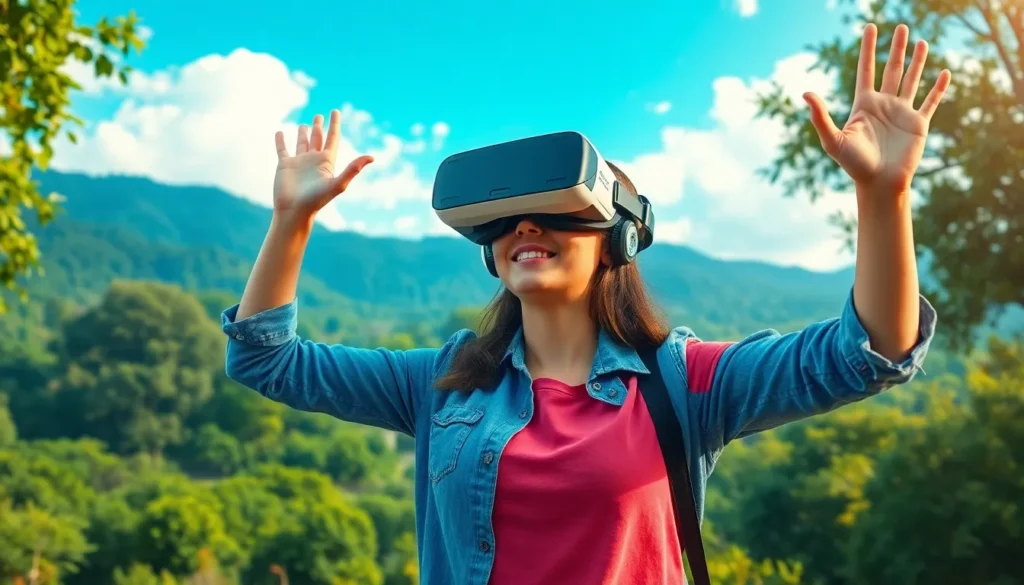Table of Contents
ToggleVirtual reality (VR) has transformed the way people experience digital environments, pushing the boundaries of immersion and interaction. At the heart of this evolution lies VR fidelity, a critical factor that determines how realistic and engaging virtual experiences can be. As technology advances, understanding VR fidelity becomes essential for developers and users alike, shaping everything from gaming to training simulations.
High fidelity in VR means more than just stunning graphics; it encompasses sound, haptic feedback, and overall responsiveness. These elements work together to create a believable virtual world, making users feel as if they truly belong in the experience. As the demand for more lifelike VR experiences grows, exploring the nuances of fidelity can help enthusiasts and professionals alike harness its full potential.
Understanding VR Fidelity
VR fidelity represents the degree of realism achieved in virtual environments, encompassing various elements that enhance immersion. High fidelity leads to more engaging and believable experiences for users.
Definition of VR Fidelity
VR fidelity refers to the accuracy and detail present in a virtual experience. This concept includes visual clarity, audio quality, haptic feedback, and interaction responsiveness. Each factor plays a significant role in achieving a lifelike representation, with higher fidelity creating a stronger connection between users and the virtual world.
Importance of VR Fidelity in Immersive Experiences
VR fidelity significantly enhances immersive experiences by ensuring realism. High-quality graphics create visually appealing environments, enabling users to engage with digital content. Clear audio enhances the atmospheric quality, making interactions feel more genuine. Responsive haptic feedback allows users to feel physical sensations, bridging the gap between reality and virtual interactions. Each element contributes to a cohesive experience, fostering deeper user engagement and satisfaction.
Factors Influencing VR Fidelity

Several key aspects determine VR fidelity, ultimately shaping the user experience. Visual, audio, and interactive elements play pivotal roles in achieving high levels of realism in virtual environments.
Visual Fidelity
Visual fidelity includes parameters like resolution, frame rate, and graphical detail. Higher resolutions, such as 4K, improve clarity, allowing users to discern intricate details in virtual spaces. Frame rates above 90 frames per second create smoother motion, reducing motion sickness and enhancing immersion. Advanced rendering techniques, including ray tracing, contribute to realistic lighting and shadow effects, fostering a more believable environment. Texture quality further impacts visual fidelity; high-resolution textures provide depth and realism, making virtual objects appear tangible.
Audio Fidelity
Audio fidelity encompasses sound quality, spatial audio, and environmental acoustics. High-quality audio systems deliver clear sounds that enhance immersion. Spatial audio technology simulates directionality, making sounds come from specific locations within the VR experience, mirroring real-world audio perception. Environmental acoustics mimic the natural sounds of virtual spaces, adding depth to the auditory experience. Incorporating asynchronous sounds, such as footsteps or ambient noises, bolsters realism and keeps users engaged.
Interactivity and Responsiveness
Interactivity and responsiveness involve the seamless interaction between users and the virtual environment. Low latency is crucial; it ensures a quick response to user actions, reducing disconnection between real and virtual entities. Intuitive controls boost user engagement, allowing for natural movements and actions. Incorporating haptic feedback enhances this interaction, letting users feel sensations associated with their actions, such as collisions or object manipulation, enriching the overall experience.
Measuring VR Fidelity
Measuring VR fidelity involves both objective metrics and subjective assessment. Each method plays a vital role in evaluating and enhancing virtual reality experiences.
Objective Metrics
Objective metrics provide quantifiable data to assess VR fidelity. Key metrics include:
- Resolution: Higher pixel density improves image clarity, allowing for more detailed environments.
- Frame Rate: A minimum of 90 frames per second is necessary for smooth motion, reducing motion sickness and enhancing fluidity.
- Latency: Targeting latency below 20 milliseconds ensures quick user response times, essential for immersion.
- Field of View (FOV): Wider FOV enhances peripheral vision, creating a more encompassing virtual environment.
These metrics establish a foundation for VR developers to analyze and improve visual and interactive quality effectively.
Subjective Assessment
Subjective assessment captures users’ personal experiences and satisfaction levels in VR environments. Key focuses include:
- User Feedback: Gather user input through surveys and focus groups to understand emotional reactions and engagement levels.
- Immersion Level: Evaluate how well users feel present in the virtual space, influenced by elements like sound and visual quality.
- Comfort Rating: Measure user comfort during extended VR sessions to identify issues like motion sickness or visual strain.
This qualitative data helps developers understand user perceptions and preferences, informing design choices that enhance overall fidelity.
Impact of VR Fidelity on User Experience
VR fidelity significantly influences user experience, shaping engagement and immersion within virtual environments. High fidelity enhances realism, which plays a crucial role in how users perceive and interact with VR content.
User Engagement and Immersion
User engagement increases with higher VR fidelity. Enhanced visual fidelity through higher resolutions and frame rates provides users with clearer and more detailed images. Improved audio fidelity, including spatial sound, creates a more realistic auditory landscape, reinforcing immersion. Effective haptic feedback allows users to feel sensations related to their actions, deepening their connection to the virtual world. Increased interactivity and responsiveness, driven by low latency and intuitive controls, contribute to a seamless experience, keeping users actively involved in their surroundings.
Psychological Effects
The psychological effects of VR fidelity manifest through heightened emotions and stronger reactions. Realistic environments evoke emotional responses, enhancing the overall experience. Users often display increased empathy and connection during immersive scenarios, such as educational or training simulations. High-fidelity experiences reduce feelings of disorientation and discomfort, enabling longer engagement periods and greater satisfaction. Positive psychological responses are linked to perceived realism, reinforcing the importance of maintaining high fidelity in VR design.
VR fidelity stands as a cornerstone of immersive digital experiences. By prioritizing high-quality visuals, sound, and interactivity, developers can create environments that resonate deeply with users. This not only enhances engagement but also fosters emotional connections that keep users invested in their virtual journeys. As technology continues to evolve, the emphasis on achieving and measuring fidelity will play a crucial role in shaping the future of virtual reality. Embracing these principles will ensure that users enjoy richer and more satisfying experiences in the ever-expanding world of VR.




